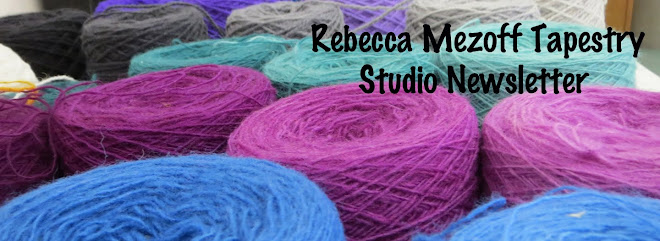My landlady wrote a book (Life on the Rocks by Katherine Wells) which mentions cochineal on the mesa and I remembered a couple years ago seeing some white fuzz on some prickly pear cactus a mile or so from the house. This morning in the rain I went back to check, and sure enough, it was cochineal!
After some online research and a return to the Colorways Summer 2011 online magazine (there are some fascinating photos in the article in this emag of the bugs on the cactus: "Sell me your gold, silver, cochineal..." by Linda Ligon) I learned a few more things about cochineal:
- There are about 70,000 bugs in a pound of cochineal. I won't be using the ones on my mesa any time soon for dyeing.
- The insect produces carminic acid (17-24% of the weight of the dried insect per Wikipedia--which we all know is ALWAYS correct) which is used to make cochineal dye.
- It used to be used extensively for dyeing fabric, but now is used largely in the cosmetics and food industries as a red dye. At least it isn't carcinogenic!
- The insects create the powdery/webby patches for protection, camouflage and to prevent dessication. My cochineal bugs were very well protected as the bugs were deep inside their webs.
- They like prickly pear cactus the best.
- They do range into NM but are generally at lower elevations than this mesa (about 5,600 feet)
- When their eggs hatch, the nymphs crawl to new areas on the cactus or using the waxy substance they are surrounded with, "balloon" to a new host cactus. Then--get this--they start feeding on the cactus, molt and lose their legs. (!) That would seem to make further transportation a bit difficult.
- It looks like cochineal currently sells for twice the price of silver by weight.
- I found this interesting cochineal farm in Oaxaca that gives tours. And they have a workshop you can take about cultivating cochineal. This sounds like my kind of vacation! Unfortunately I'd probably have to move south to grow them in the US. It'll be hard to dye much yarn with 10 bugs... and I don't want to kill the entire crop either. Unfortunately dyeing with them seems to involve death on the part of the bug (when they are pregnant!).
- And after all this fascinating information, I had to pull out my color books. From Colors: What they mean and how to make them by Anne Varichon, I found out that there are actually three primary kinds of cochineal. Besides the Mexican kind that live largely on nopal (prickly pear) cactus, there is the Armenian cochineal which lives on reeds and grasses in Armenia and Turkey and the Polish cochineal which feeds on German knotgrass and lives near the Baltic Sea and in the Ukraine (p 124).
- Some history from the same book (p 124): dyeing with cochineal seems to have been done since about 700 BCE in Peru and large fields were cultivated long before the arrival of the Spanish. The Conquistadors realized that this insect represented enormous wealth and escalated production. Starting in 1520, they exported hundreds of tons of cochineals to Europe and around the world.
- The annual yield of the nopales fields in southern Mexico can be 264 pounds of insects per acre.
"Spanish Red, I noted in my diary that night, is usually born between the fog and the frost in places where land is cheap and the prickly pear, on which it is a parasite, grows in abundance on the desert sands. It is a holy blight, a noble rot where the treasure is rubies rather than the gold of dessert wine. It is a deep, intensely colored organic red, but it will never be used for Buddhist robes because there is too much death in it. In the twenty-first century women around the world coat their lips with insect blood, we apparently dab our cheeks with it, and in the United States it is one of few permitted red constituents of eye shadow. 'And finally,' I wrote with a happy frisson, 'Cherry Coke is full of it; it is color additive E120.'" [Finlay, V. (2002). Color: A natural history of the palette. New York: Random House. p 137-8.]
Weave well friends! (and when you dye with cochineal, remember all the little bug souls)

































